Analyzing PepsiCo's Business Strategy: VRIN, SWOT, and Stakeholder
VerifiedAdded on 2020/11/23
|13
|4043
|223
Report
AI Summary
This report provides a comprehensive analysis of PepsiCo's business strategy, employing various frameworks and theories. It begins with a VRIN analysis to identify PepsiCo's valuable, rare, inimitable, and non-substitutable resources, highlighting its secret formula and reputational resources as key sources of sustainable competitive advantage. A SWOT analysis assesses the company's strengths (brand image, global distribution network, secret formula), weaknesses (competition with Coca-Cola, perceived unhealthiness of products), opportunities (healthier product development, flavor innovation), and threats (competition, health regulations). The report also examines stakeholder theory, outlining PepsiCo's vision, mission, and governance chain, emphasizing accountability, fairness, and transparency. Different governance structures are compared, along with their advantages and disadvantages. Corporate Social Responsibility stances and the relation of ethical issues to strategic purpose are also discussed. Finally, the report touches upon organizational culture using Hofstede's Cultural Dimensions Model and considers appropriate strategies for PepsiCo's future development using the Ansoff Matrix. The document is available on Desklib, a platform offering study tools and resources for students.
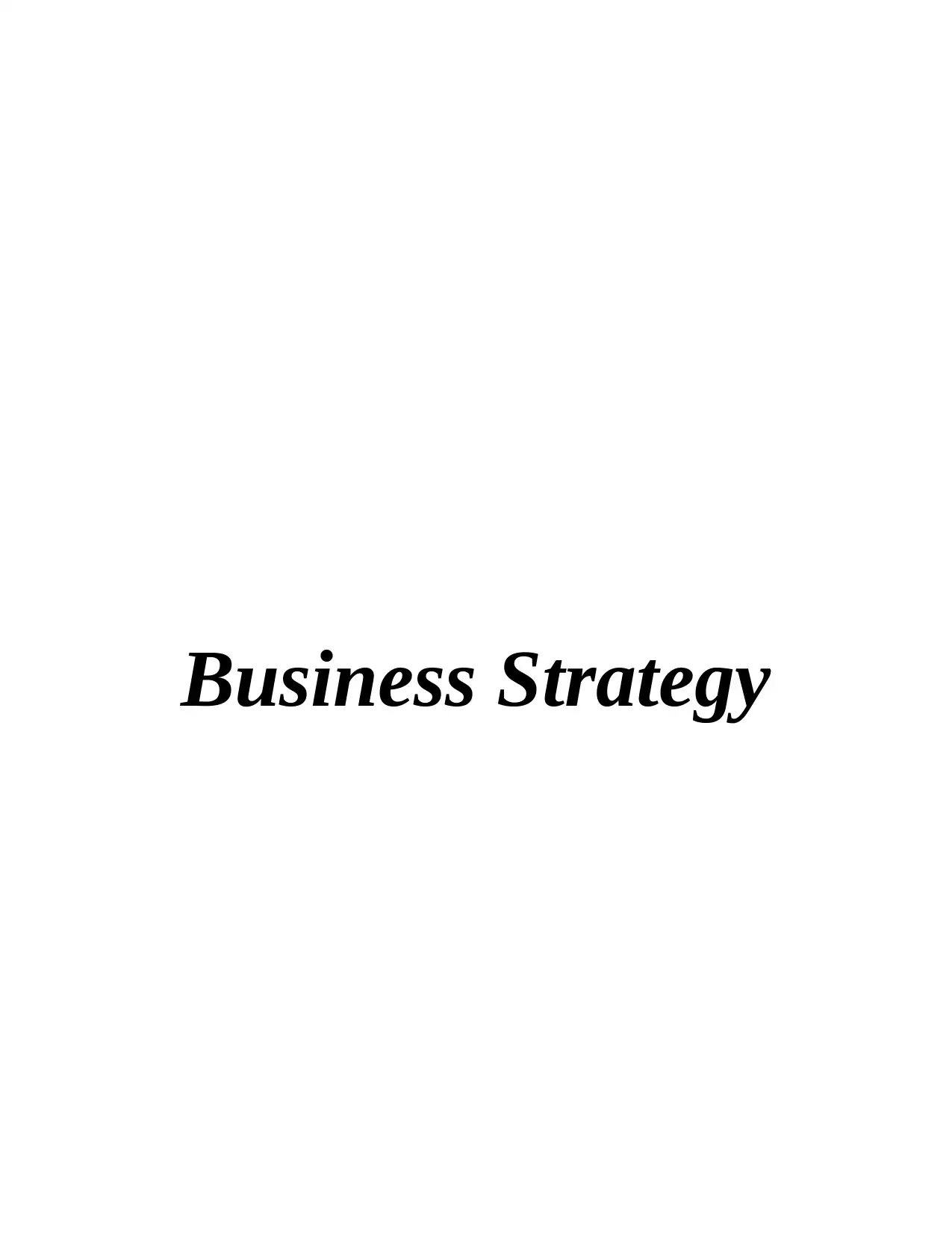
Business Strategy
Paraphrase This Document
Need a fresh take? Get an instant paraphrase of this document with our AI Paraphraser

Table of Contents
INTRODUCTION...........................................................................................................................1
MAIN BODY...................................................................................................................................1
VRIN Analysis and SWOT Analysis..........................................................................................1
Stakeholders Theory....................................................................................................................4
Theories Related to Organisation Culture...................................................................................8
Application of Porter's Generic Model.......................................................................................9
CONCLUSION................................................................................................................................9
REFERENCES..............................................................................................................................11
INTRODUCTION...........................................................................................................................1
MAIN BODY...................................................................................................................................1
VRIN Analysis and SWOT Analysis..........................................................................................1
Stakeholders Theory....................................................................................................................4
Theories Related to Organisation Culture...................................................................................8
Application of Porter's Generic Model.......................................................................................9
CONCLUSION................................................................................................................................9
REFERENCES..............................................................................................................................11
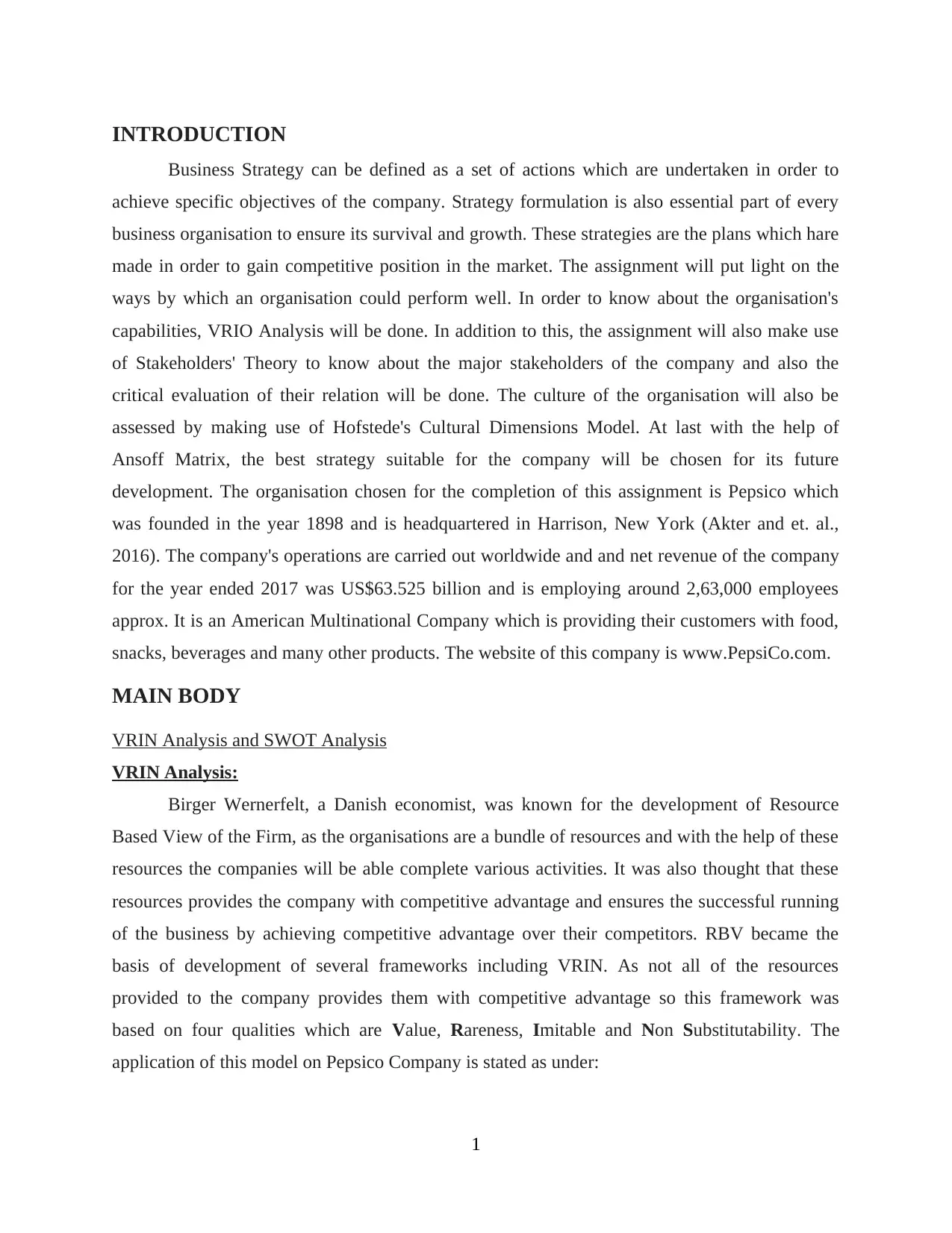
INTRODUCTION
Business Strategy can be defined as a set of actions which are undertaken in order to
achieve specific objectives of the company. Strategy formulation is also essential part of every
business organisation to ensure its survival and growth. These strategies are the plans which hare
made in order to gain competitive position in the market. The assignment will put light on the
ways by which an organisation could perform well. In order to know about the organisation's
capabilities, VRIO Analysis will be done. In addition to this, the assignment will also make use
of Stakeholders' Theory to know about the major stakeholders of the company and also the
critical evaluation of their relation will be done. The culture of the organisation will also be
assessed by making use of Hofstede's Cultural Dimensions Model. At last with the help of
Ansoff Matrix, the best strategy suitable for the company will be chosen for its future
development. The organisation chosen for the completion of this assignment is Pepsico which
was founded in the year 1898 and is headquartered in Harrison, New York (Akter and et. al.,
2016). The company's operations are carried out worldwide and and net revenue of the company
for the year ended 2017 was US$63.525 billion and is employing around 2,63,000 employees
approx. It is an American Multinational Company which is providing their customers with food,
snacks, beverages and many other products. The website of this company is www.PepsiCo.com.
MAIN BODY
VRIN Analysis and SWOT Analysis
VRIN Analysis:
Birger Wernerfelt, a Danish economist, was known for the development of Resource
Based View of the Firm, as the organisations are a bundle of resources and with the help of these
resources the companies will be able complete various activities. It was also thought that these
resources provides the company with competitive advantage and ensures the successful running
of the business by achieving competitive advantage over their competitors. RBV became the
basis of development of several frameworks including VRIN. As not all of the resources
provided to the company provides them with competitive advantage so this framework was
based on four qualities which are Value, Rareness, Imitable and Non Substitutability. The
application of this model on Pepsico Company is stated as under:
1
Business Strategy can be defined as a set of actions which are undertaken in order to
achieve specific objectives of the company. Strategy formulation is also essential part of every
business organisation to ensure its survival and growth. These strategies are the plans which hare
made in order to gain competitive position in the market. The assignment will put light on the
ways by which an organisation could perform well. In order to know about the organisation's
capabilities, VRIO Analysis will be done. In addition to this, the assignment will also make use
of Stakeholders' Theory to know about the major stakeholders of the company and also the
critical evaluation of their relation will be done. The culture of the organisation will also be
assessed by making use of Hofstede's Cultural Dimensions Model. At last with the help of
Ansoff Matrix, the best strategy suitable for the company will be chosen for its future
development. The organisation chosen for the completion of this assignment is Pepsico which
was founded in the year 1898 and is headquartered in Harrison, New York (Akter and et. al.,
2016). The company's operations are carried out worldwide and and net revenue of the company
for the year ended 2017 was US$63.525 billion and is employing around 2,63,000 employees
approx. It is an American Multinational Company which is providing their customers with food,
snacks, beverages and many other products. The website of this company is www.PepsiCo.com.
MAIN BODY
VRIN Analysis and SWOT Analysis
VRIN Analysis:
Birger Wernerfelt, a Danish economist, was known for the development of Resource
Based View of the Firm, as the organisations are a bundle of resources and with the help of these
resources the companies will be able complete various activities. It was also thought that these
resources provides the company with competitive advantage and ensures the successful running
of the business by achieving competitive advantage over their competitors. RBV became the
basis of development of several frameworks including VRIN. As not all of the resources
provided to the company provides them with competitive advantage so this framework was
based on four qualities which are Value, Rareness, Imitable and Non Substitutability. The
application of this model on Pepsico Company is stated as under:
1
⊘ This is a preview!⊘
Do you want full access?
Subscribe today to unlock all pages.

Trusted by 1+ million students worldwide
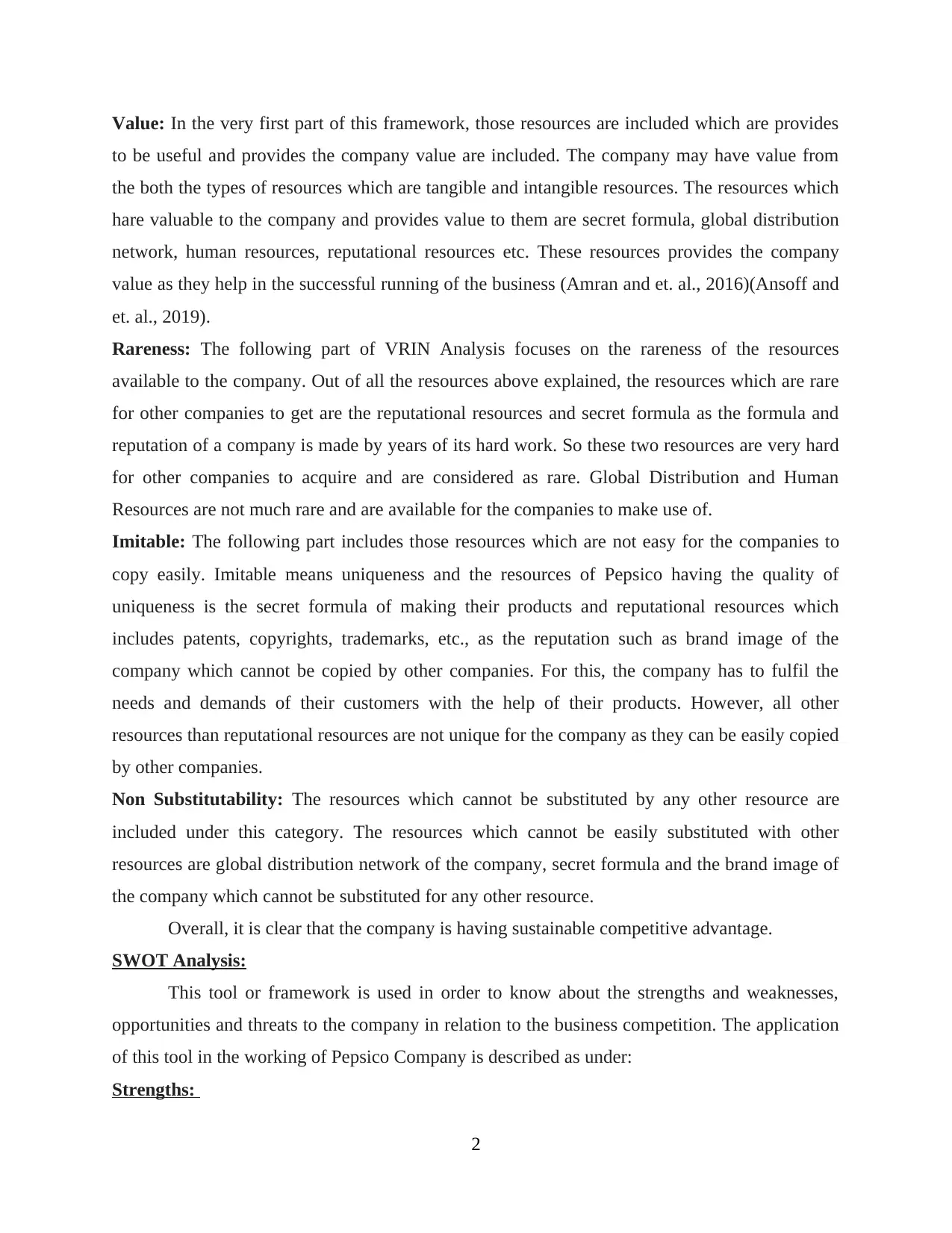
Value: In the very first part of this framework, those resources are included which are provides
to be useful and provides the company value are included. The company may have value from
the both the types of resources which are tangible and intangible resources. The resources which
hare valuable to the company and provides value to them are secret formula, global distribution
network, human resources, reputational resources etc. These resources provides the company
value as they help in the successful running of the business (Amran and et. al., 2016)(Ansoff and
et. al., 2019).
Rareness: The following part of VRIN Analysis focuses on the rareness of the resources
available to the company. Out of all the resources above explained, the resources which are rare
for other companies to get are the reputational resources and secret formula as the formula and
reputation of a company is made by years of its hard work. So these two resources are very hard
for other companies to acquire and are considered as rare. Global Distribution and Human
Resources are not much rare and are available for the companies to make use of.
Imitable: The following part includes those resources which are not easy for the companies to
copy easily. Imitable means uniqueness and the resources of Pepsico having the quality of
uniqueness is the secret formula of making their products and reputational resources which
includes patents, copyrights, trademarks, etc., as the reputation such as brand image of the
company which cannot be copied by other companies. For this, the company has to fulfil the
needs and demands of their customers with the help of their products. However, all other
resources than reputational resources are not unique for the company as they can be easily copied
by other companies.
Non Substitutability: The resources which cannot be substituted by any other resource are
included under this category. The resources which cannot be easily substituted with other
resources are global distribution network of the company, secret formula and the brand image of
the company which cannot be substituted for any other resource.
Overall, it is clear that the company is having sustainable competitive advantage.
SWOT Analysis:
This tool or framework is used in order to know about the strengths and weaknesses,
opportunities and threats to the company in relation to the business competition. The application
of this tool in the working of Pepsico Company is described as under:
Strengths:
2
to be useful and provides the company value are included. The company may have value from
the both the types of resources which are tangible and intangible resources. The resources which
hare valuable to the company and provides value to them are secret formula, global distribution
network, human resources, reputational resources etc. These resources provides the company
value as they help in the successful running of the business (Amran and et. al., 2016)(Ansoff and
et. al., 2019).
Rareness: The following part of VRIN Analysis focuses on the rareness of the resources
available to the company. Out of all the resources above explained, the resources which are rare
for other companies to get are the reputational resources and secret formula as the formula and
reputation of a company is made by years of its hard work. So these two resources are very hard
for other companies to acquire and are considered as rare. Global Distribution and Human
Resources are not much rare and are available for the companies to make use of.
Imitable: The following part includes those resources which are not easy for the companies to
copy easily. Imitable means uniqueness and the resources of Pepsico having the quality of
uniqueness is the secret formula of making their products and reputational resources which
includes patents, copyrights, trademarks, etc., as the reputation such as brand image of the
company which cannot be copied by other companies. For this, the company has to fulfil the
needs and demands of their customers with the help of their products. However, all other
resources than reputational resources are not unique for the company as they can be easily copied
by other companies.
Non Substitutability: The resources which cannot be substituted by any other resource are
included under this category. The resources which cannot be easily substituted with other
resources are global distribution network of the company, secret formula and the brand image of
the company which cannot be substituted for any other resource.
Overall, it is clear that the company is having sustainable competitive advantage.
SWOT Analysis:
This tool or framework is used in order to know about the strengths and weaknesses,
opportunities and threats to the company in relation to the business competition. The application
of this tool in the working of Pepsico Company is described as under:
Strengths:
2
Paraphrase This Document
Need a fresh take? Get an instant paraphrase of this document with our AI Paraphraser
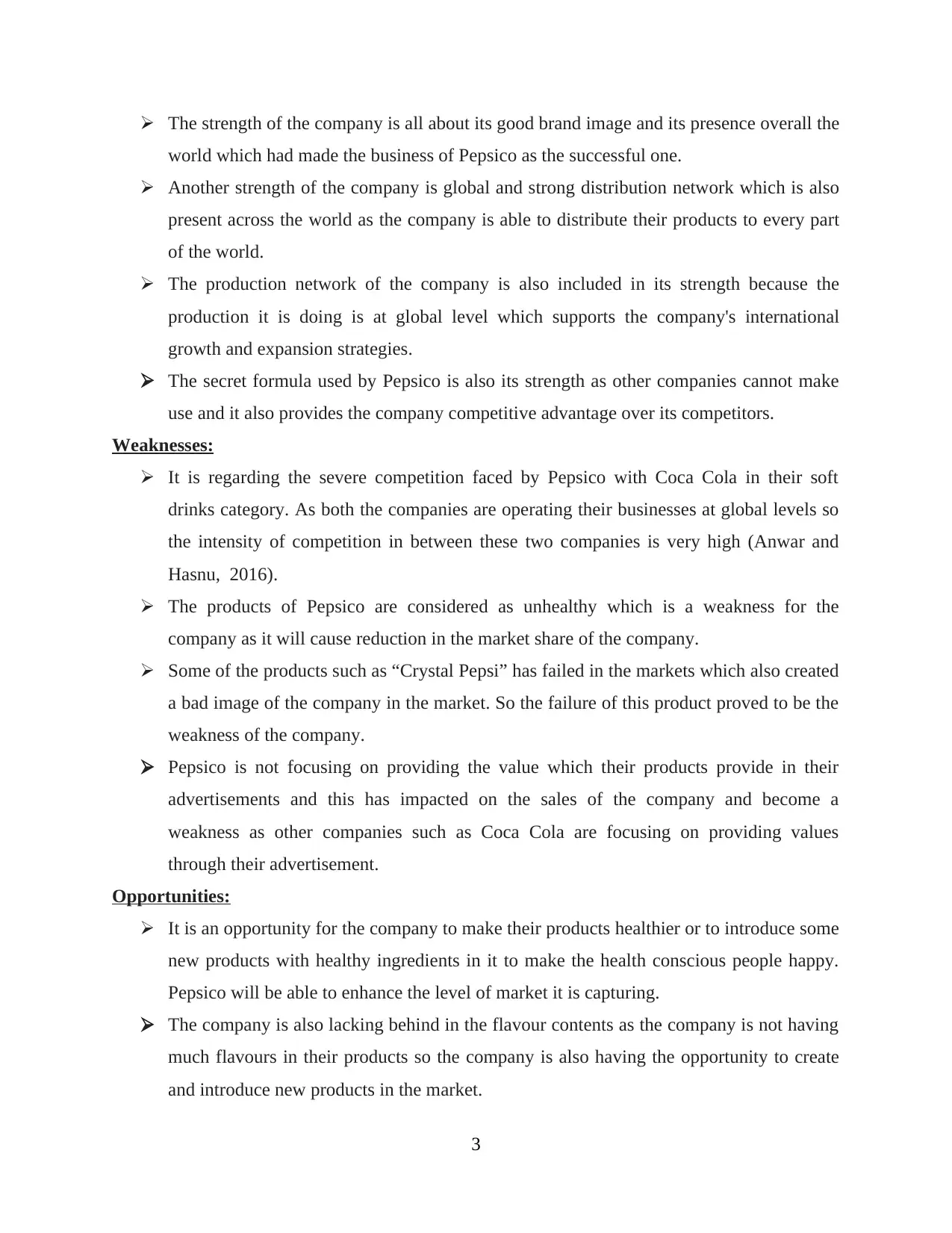
The strength of the company is all about its good brand image and its presence overall the
world which had made the business of Pepsico as the successful one.
Another strength of the company is global and strong distribution network which is also
present across the world as the company is able to distribute their products to every part
of the world.
The production network of the company is also included in its strength because the
production it is doing is at global level which supports the company's international
growth and expansion strategies.
The secret formula used by Pepsico is also its strength as other companies cannot make
use and it also provides the company competitive advantage over its competitors.
Weaknesses:
It is regarding the severe competition faced by Pepsico with Coca Cola in their soft
drinks category. As both the companies are operating their businesses at global levels so
the intensity of competition in between these two companies is very high (Anwar and
Hasnu, 2016).
The products of Pepsico are considered as unhealthy which is a weakness for the
company as it will cause reduction in the market share of the company.
Some of the products such as “Crystal Pepsi” has failed in the markets which also created
a bad image of the company in the market. So the failure of this product proved to be the
weakness of the company.
Pepsico is not focusing on providing the value which their products provide in their
advertisements and this has impacted on the sales of the company and become a
weakness as other companies such as Coca Cola are focusing on providing values
through their advertisement.
Opportunities:
It is an opportunity for the company to make their products healthier or to introduce some
new products with healthy ingredients in it to make the health conscious people happy.
Pepsico will be able to enhance the level of market it is capturing.
The company is also lacking behind in the flavour contents as the company is not having
much flavours in their products so the company is also having the opportunity to create
and introduce new products in the market.
3
world which had made the business of Pepsico as the successful one.
Another strength of the company is global and strong distribution network which is also
present across the world as the company is able to distribute their products to every part
of the world.
The production network of the company is also included in its strength because the
production it is doing is at global level which supports the company's international
growth and expansion strategies.
The secret formula used by Pepsico is also its strength as other companies cannot make
use and it also provides the company competitive advantage over its competitors.
Weaknesses:
It is regarding the severe competition faced by Pepsico with Coca Cola in their soft
drinks category. As both the companies are operating their businesses at global levels so
the intensity of competition in between these two companies is very high (Anwar and
Hasnu, 2016).
The products of Pepsico are considered as unhealthy which is a weakness for the
company as it will cause reduction in the market share of the company.
Some of the products such as “Crystal Pepsi” has failed in the markets which also created
a bad image of the company in the market. So the failure of this product proved to be the
weakness of the company.
Pepsico is not focusing on providing the value which their products provide in their
advertisements and this has impacted on the sales of the company and become a
weakness as other companies such as Coca Cola are focusing on providing values
through their advertisement.
Opportunities:
It is an opportunity for the company to make their products healthier or to introduce some
new products with healthy ingredients in it to make the health conscious people happy.
Pepsico will be able to enhance the level of market it is capturing.
The company is also lacking behind in the flavour contents as the company is not having
much flavours in their products so the company is also having the opportunity to create
and introduce new products in the market.
3
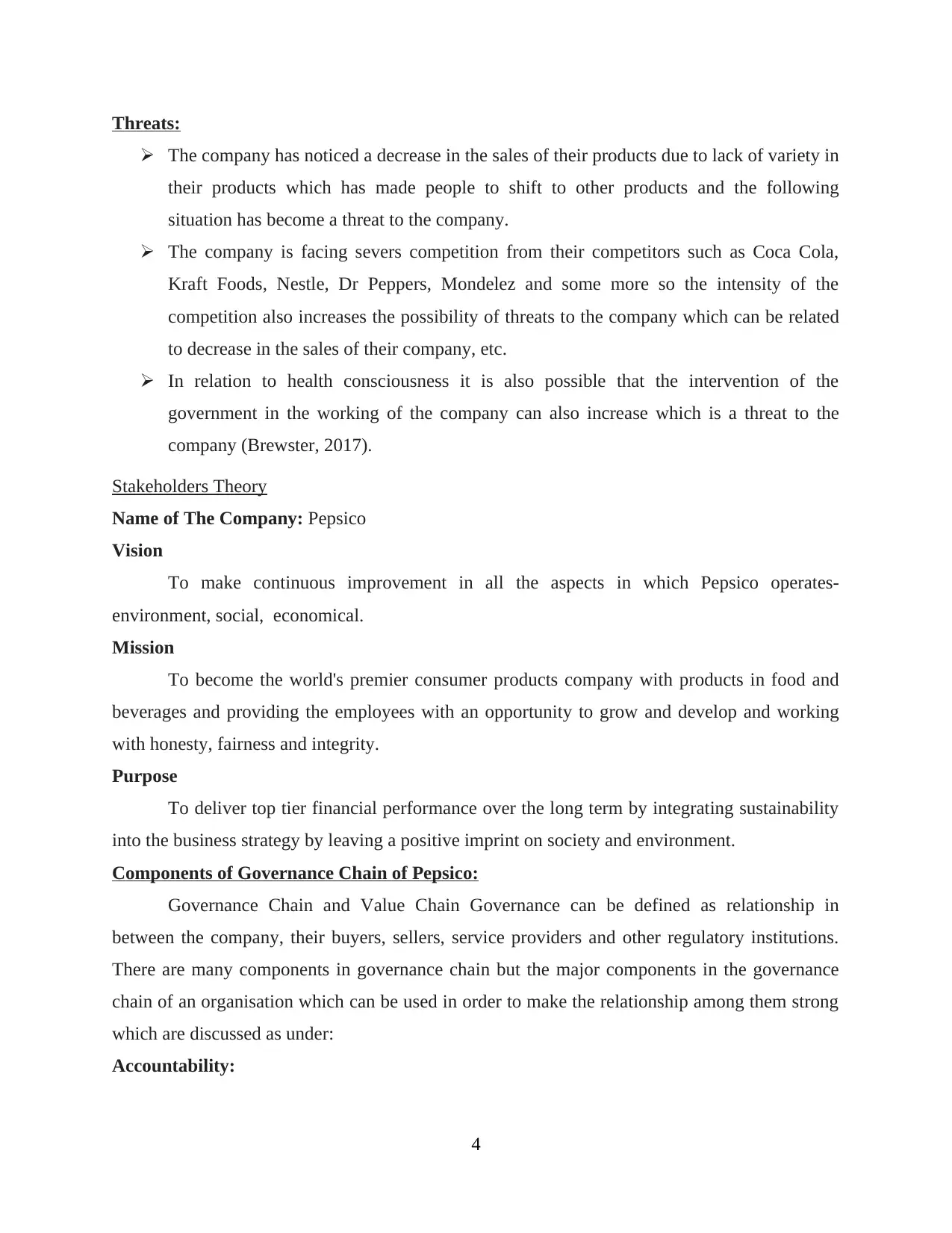
Threats:
The company has noticed a decrease in the sales of their products due to lack of variety in
their products which has made people to shift to other products and the following
situation has become a threat to the company.
The company is facing severs competition from their competitors such as Coca Cola,
Kraft Foods, Nestle, Dr Peppers, Mondelez and some more so the intensity of the
competition also increases the possibility of threats to the company which can be related
to decrease in the sales of their company, etc.
In relation to health consciousness it is also possible that the intervention of the
government in the working of the company can also increase which is a threat to the
company (Brewster, 2017).
Stakeholders Theory
Name of The Company: Pepsico
Vision
To make continuous improvement in all the aspects in which Pepsico operates-
environment, social, economical.
Mission
To become the world's premier consumer products company with products in food and
beverages and providing the employees with an opportunity to grow and develop and working
with honesty, fairness and integrity.
Purpose
To deliver top tier financial performance over the long term by integrating sustainability
into the business strategy by leaving a positive imprint on society and environment.
Components of Governance Chain of Pepsico:
Governance Chain and Value Chain Governance can be defined as relationship in
between the company, their buyers, sellers, service providers and other regulatory institutions.
There are many components in governance chain but the major components in the governance
chain of an organisation which can be used in order to make the relationship among them strong
which are discussed as under:
Accountability:
4
The company has noticed a decrease in the sales of their products due to lack of variety in
their products which has made people to shift to other products and the following
situation has become a threat to the company.
The company is facing severs competition from their competitors such as Coca Cola,
Kraft Foods, Nestle, Dr Peppers, Mondelez and some more so the intensity of the
competition also increases the possibility of threats to the company which can be related
to decrease in the sales of their company, etc.
In relation to health consciousness it is also possible that the intervention of the
government in the working of the company can also increase which is a threat to the
company (Brewster, 2017).
Stakeholders Theory
Name of The Company: Pepsico
Vision
To make continuous improvement in all the aspects in which Pepsico operates-
environment, social, economical.
Mission
To become the world's premier consumer products company with products in food and
beverages and providing the employees with an opportunity to grow and develop and working
with honesty, fairness and integrity.
Purpose
To deliver top tier financial performance over the long term by integrating sustainability
into the business strategy by leaving a positive imprint on society and environment.
Components of Governance Chain of Pepsico:
Governance Chain and Value Chain Governance can be defined as relationship in
between the company, their buyers, sellers, service providers and other regulatory institutions.
There are many components in governance chain but the major components in the governance
chain of an organisation which can be used in order to make the relationship among them strong
which are discussed as under:
Accountability:
4
⊘ This is a preview!⊘
Do you want full access?
Subscribe today to unlock all pages.

Trusted by 1+ million students worldwide
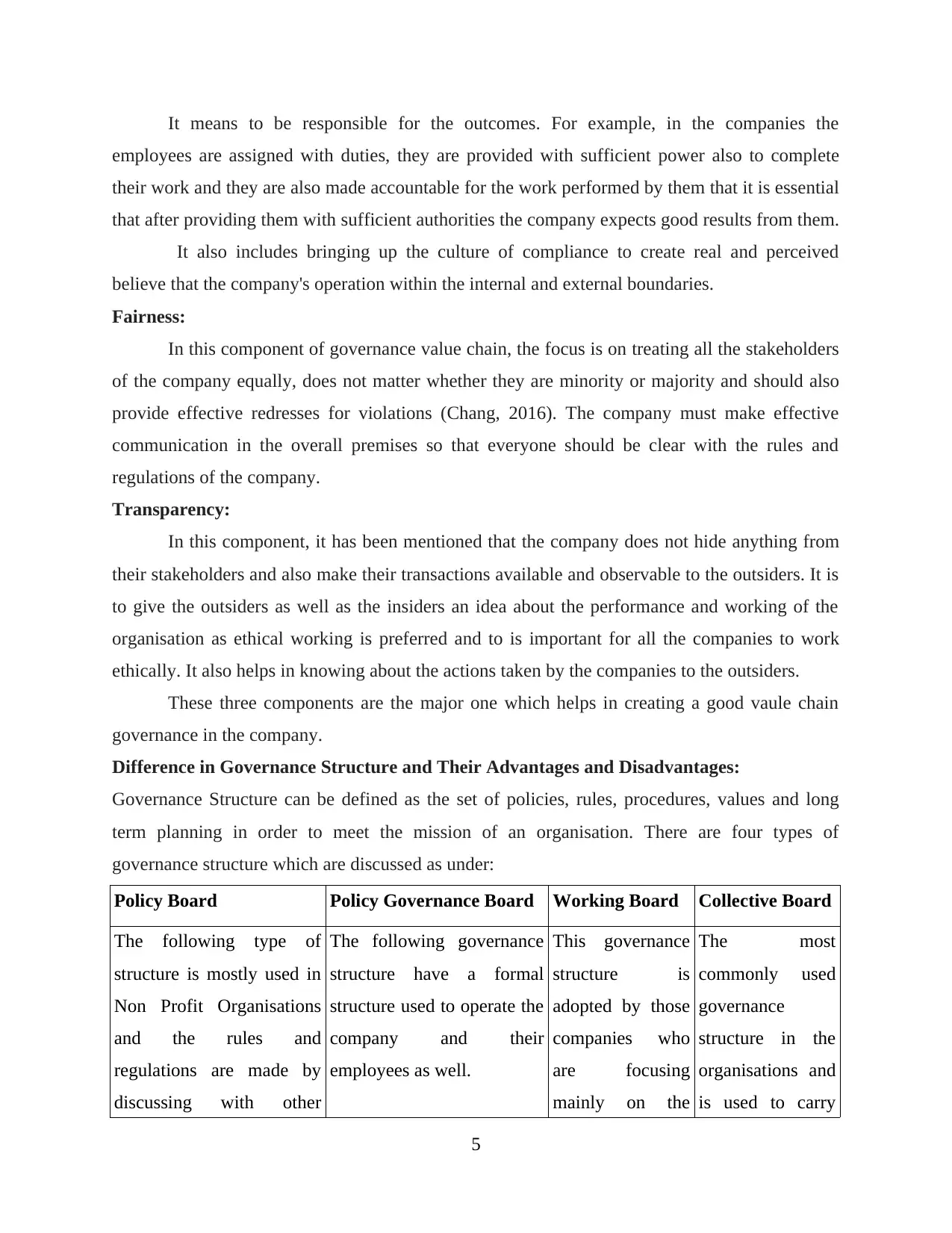
It means to be responsible for the outcomes. For example, in the companies the
employees are assigned with duties, they are provided with sufficient power also to complete
their work and they are also made accountable for the work performed by them that it is essential
that after providing them with sufficient authorities the company expects good results from them.
It also includes bringing up the culture of compliance to create real and perceived
believe that the company's operation within the internal and external boundaries.
Fairness:
In this component of governance value chain, the focus is on treating all the stakeholders
of the company equally, does not matter whether they are minority or majority and should also
provide effective redresses for violations (Chang, 2016). The company must make effective
communication in the overall premises so that everyone should be clear with the rules and
regulations of the company.
Transparency:
In this component, it has been mentioned that the company does not hide anything from
their stakeholders and also make their transactions available and observable to the outsiders. It is
to give the outsiders as well as the insiders an idea about the performance and working of the
organisation as ethical working is preferred and to is important for all the companies to work
ethically. It also helps in knowing about the actions taken by the companies to the outsiders.
These three components are the major one which helps in creating a good vaule chain
governance in the company.
Difference in Governance Structure and Their Advantages and Disadvantages:
Governance Structure can be defined as the set of policies, rules, procedures, values and long
term planning in order to meet the mission of an organisation. There are four types of
governance structure which are discussed as under:
Policy Board Policy Governance Board Working Board Collective Board
The following type of
structure is mostly used in
Non Profit Organisations
and the rules and
regulations are made by
discussing with other
The following governance
structure have a formal
structure used to operate the
company and their
employees as well.
This governance
structure is
adopted by those
companies who
are focusing
mainly on the
The most
commonly used
governance
structure in the
organisations and
is used to carry
5
employees are assigned with duties, they are provided with sufficient power also to complete
their work and they are also made accountable for the work performed by them that it is essential
that after providing them with sufficient authorities the company expects good results from them.
It also includes bringing up the culture of compliance to create real and perceived
believe that the company's operation within the internal and external boundaries.
Fairness:
In this component of governance value chain, the focus is on treating all the stakeholders
of the company equally, does not matter whether they are minority or majority and should also
provide effective redresses for violations (Chang, 2016). The company must make effective
communication in the overall premises so that everyone should be clear with the rules and
regulations of the company.
Transparency:
In this component, it has been mentioned that the company does not hide anything from
their stakeholders and also make their transactions available and observable to the outsiders. It is
to give the outsiders as well as the insiders an idea about the performance and working of the
organisation as ethical working is preferred and to is important for all the companies to work
ethically. It also helps in knowing about the actions taken by the companies to the outsiders.
These three components are the major one which helps in creating a good vaule chain
governance in the company.
Difference in Governance Structure and Their Advantages and Disadvantages:
Governance Structure can be defined as the set of policies, rules, procedures, values and long
term planning in order to meet the mission of an organisation. There are four types of
governance structure which are discussed as under:
Policy Board Policy Governance Board Working Board Collective Board
The following type of
structure is mostly used in
Non Profit Organisations
and the rules and
regulations are made by
discussing with other
The following governance
structure have a formal
structure used to operate the
company and their
employees as well.
This governance
structure is
adopted by those
companies who
are focusing
mainly on the
The most
commonly used
governance
structure in the
organisations and
is used to carry
5
Paraphrase This Document
Need a fresh take? Get an instant paraphrase of this document with our AI Paraphraser
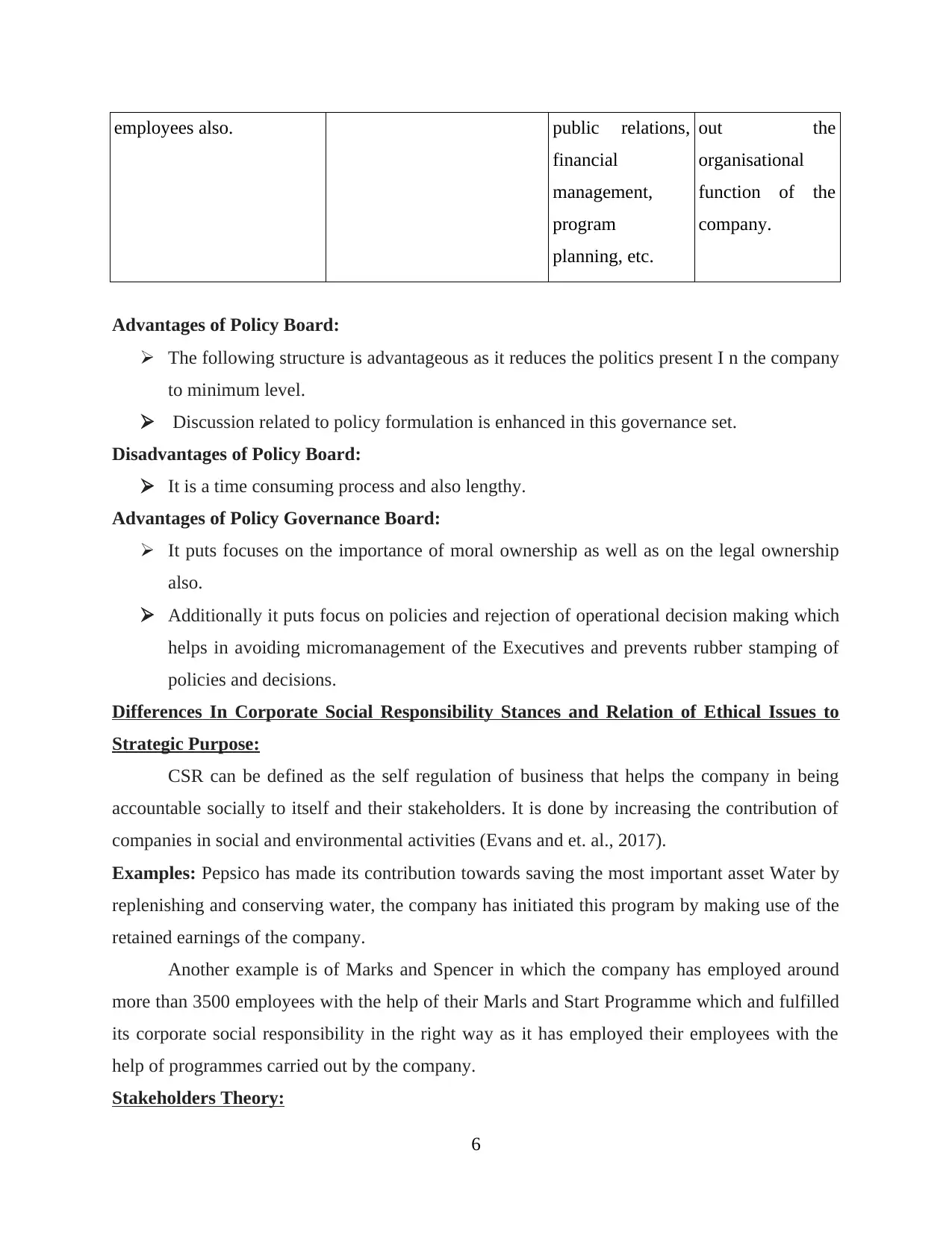
employees also. public relations,
financial
management,
program
planning, etc.
out the
organisational
function of the
company.
Advantages of Policy Board:
The following structure is advantageous as it reduces the politics present I n the company
to minimum level.
Discussion related to policy formulation is enhanced in this governance set.
Disadvantages of Policy Board:
It is a time consuming process and also lengthy.
Advantages of Policy Governance Board:
It puts focuses on the importance of moral ownership as well as on the legal ownership
also.
Additionally it puts focus on policies and rejection of operational decision making which
helps in avoiding micromanagement of the Executives and prevents rubber stamping of
policies and decisions.
Differences In Corporate Social Responsibility Stances and Relation of Ethical Issues to
Strategic Purpose:
CSR can be defined as the self regulation of business that helps the company in being
accountable socially to itself and their stakeholders. It is done by increasing the contribution of
companies in social and environmental activities (Evans and et. al., 2017).
Examples: Pepsico has made its contribution towards saving the most important asset Water by
replenishing and conserving water, the company has initiated this program by making use of the
retained earnings of the company.
Another example is of Marks and Spencer in which the company has employed around
more than 3500 employees with the help of their Marls and Start Programme which and fulfilled
its corporate social responsibility in the right way as it has employed their employees with the
help of programmes carried out by the company.
Stakeholders Theory:
6
financial
management,
program
planning, etc.
out the
organisational
function of the
company.
Advantages of Policy Board:
The following structure is advantageous as it reduces the politics present I n the company
to minimum level.
Discussion related to policy formulation is enhanced in this governance set.
Disadvantages of Policy Board:
It is a time consuming process and also lengthy.
Advantages of Policy Governance Board:
It puts focuses on the importance of moral ownership as well as on the legal ownership
also.
Additionally it puts focus on policies and rejection of operational decision making which
helps in avoiding micromanagement of the Executives and prevents rubber stamping of
policies and decisions.
Differences In Corporate Social Responsibility Stances and Relation of Ethical Issues to
Strategic Purpose:
CSR can be defined as the self regulation of business that helps the company in being
accountable socially to itself and their stakeholders. It is done by increasing the contribution of
companies in social and environmental activities (Evans and et. al., 2017).
Examples: Pepsico has made its contribution towards saving the most important asset Water by
replenishing and conserving water, the company has initiated this program by making use of the
retained earnings of the company.
Another example is of Marks and Spencer in which the company has employed around
more than 3500 employees with the help of their Marls and Start Programme which and fulfilled
its corporate social responsibility in the right way as it has employed their employees with the
help of programmes carried out by the company.
Stakeholders Theory:
6
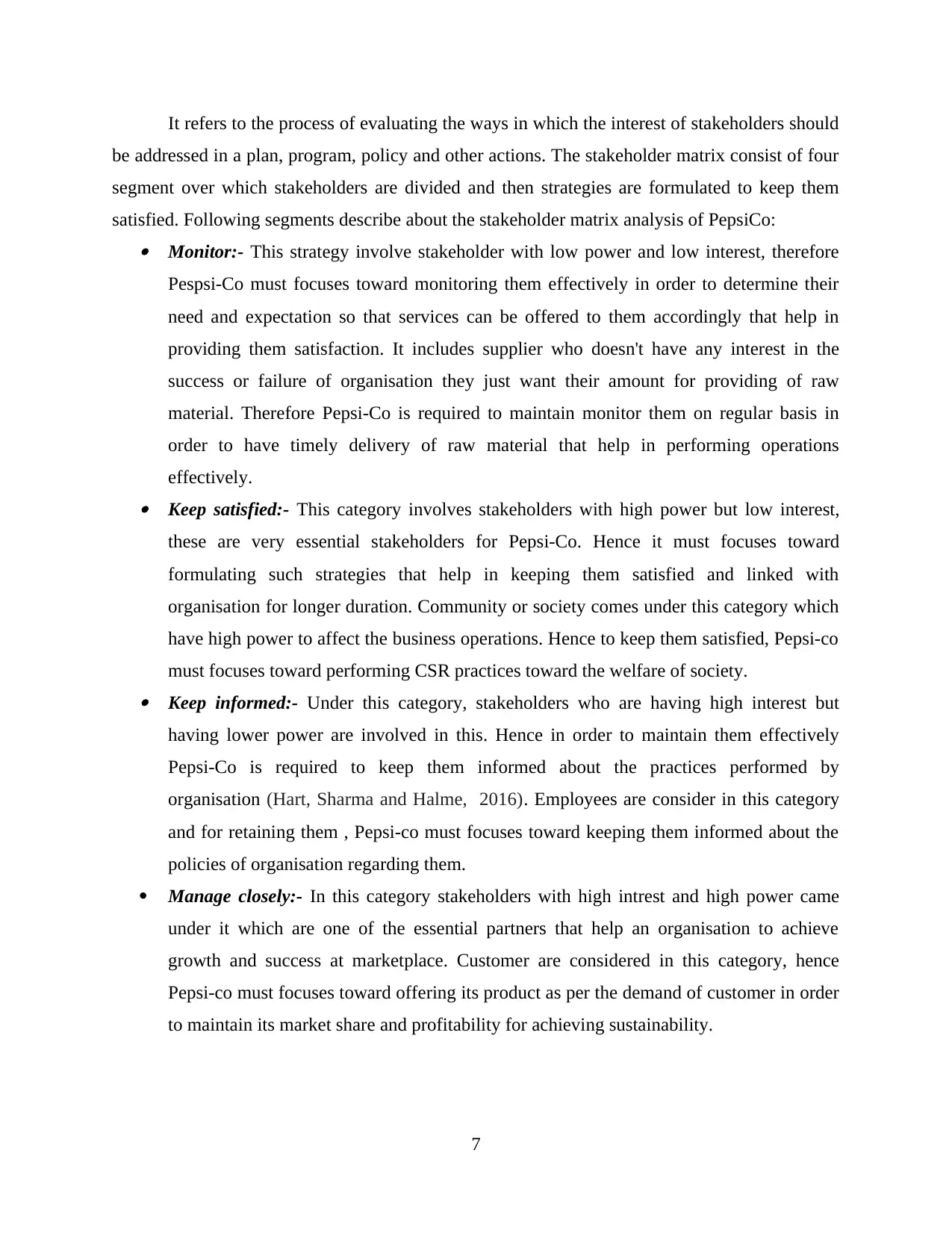
It refers to the process of evaluating the ways in which the interest of stakeholders should
be addressed in a plan, program, policy and other actions. The stakeholder matrix consist of four
segment over which stakeholders are divided and then strategies are formulated to keep them
satisfied. Following segments describe about the stakeholder matrix analysis of PepsiCo: Monitor:- This strategy involve stakeholder with low power and low interest, therefore
Pespsi-Co must focuses toward monitoring them effectively in order to determine their
need and expectation so that services can be offered to them accordingly that help in
providing them satisfaction. It includes supplier who doesn't have any interest in the
success or failure of organisation they just want their amount for providing of raw
material. Therefore Pepsi-Co is required to maintain monitor them on regular basis in
order to have timely delivery of raw material that help in performing operations
effectively. Keep satisfied:- This category involves stakeholders with high power but low interest,
these are very essential stakeholders for Pepsi-Co. Hence it must focuses toward
formulating such strategies that help in keeping them satisfied and linked with
organisation for longer duration. Community or society comes under this category which
have high power to affect the business operations. Hence to keep them satisfied, Pepsi-co
must focuses toward performing CSR practices toward the welfare of society. Keep informed:- Under this category, stakeholders who are having high interest but
having lower power are involved in this. Hence in order to maintain them effectively
Pepsi-Co is required to keep them informed about the practices performed by
organisation (Hart, Sharma and Halme, 2016). Employees are consider in this category
and for retaining them , Pepsi-co must focuses toward keeping them informed about the
policies of organisation regarding them.
Manage closely:- In this category stakeholders with high intrest and high power came
under it which are one of the essential partners that help an organisation to achieve
growth and success at marketplace. Customer are considered in this category, hence
Pepsi-co must focuses toward offering its product as per the demand of customer in order
to maintain its market share and profitability for achieving sustainability.
7
be addressed in a plan, program, policy and other actions. The stakeholder matrix consist of four
segment over which stakeholders are divided and then strategies are formulated to keep them
satisfied. Following segments describe about the stakeholder matrix analysis of PepsiCo: Monitor:- This strategy involve stakeholder with low power and low interest, therefore
Pespsi-Co must focuses toward monitoring them effectively in order to determine their
need and expectation so that services can be offered to them accordingly that help in
providing them satisfaction. It includes supplier who doesn't have any interest in the
success or failure of organisation they just want their amount for providing of raw
material. Therefore Pepsi-Co is required to maintain monitor them on regular basis in
order to have timely delivery of raw material that help in performing operations
effectively. Keep satisfied:- This category involves stakeholders with high power but low interest,
these are very essential stakeholders for Pepsi-Co. Hence it must focuses toward
formulating such strategies that help in keeping them satisfied and linked with
organisation for longer duration. Community or society comes under this category which
have high power to affect the business operations. Hence to keep them satisfied, Pepsi-co
must focuses toward performing CSR practices toward the welfare of society. Keep informed:- Under this category, stakeholders who are having high interest but
having lower power are involved in this. Hence in order to maintain them effectively
Pepsi-Co is required to keep them informed about the practices performed by
organisation (Hart, Sharma and Halme, 2016). Employees are consider in this category
and for retaining them , Pepsi-co must focuses toward keeping them informed about the
policies of organisation regarding them.
Manage closely:- In this category stakeholders with high intrest and high power came
under it which are one of the essential partners that help an organisation to achieve
growth and success at marketplace. Customer are considered in this category, hence
Pepsi-co must focuses toward offering its product as per the demand of customer in order
to maintain its market share and profitability for achieving sustainability.
7
⊘ This is a preview!⊘
Do you want full access?
Subscribe today to unlock all pages.

Trusted by 1+ million students worldwide
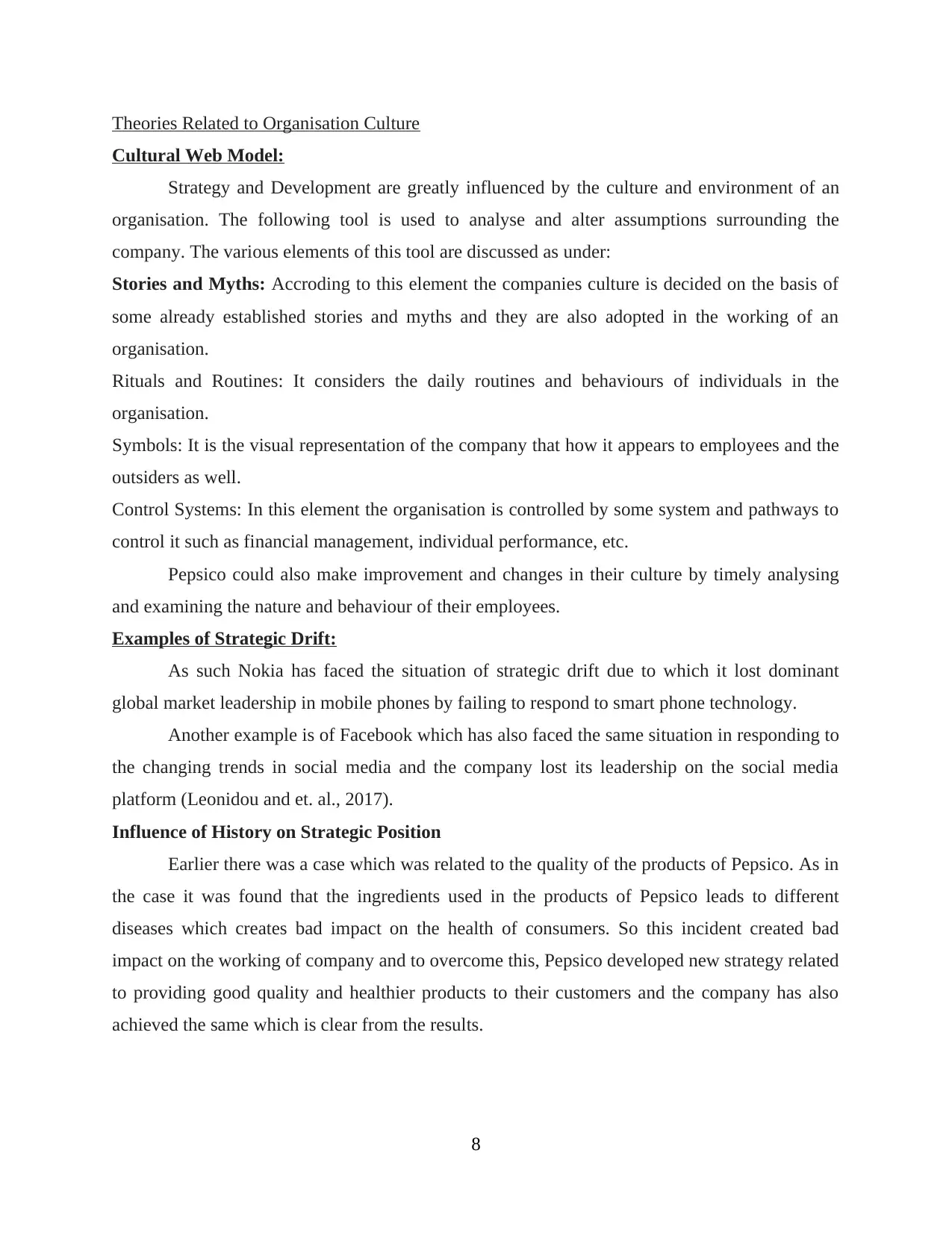
Theories Related to Organisation Culture
Cultural Web Model:
Strategy and Development are greatly influenced by the culture and environment of an
organisation. The following tool is used to analyse and alter assumptions surrounding the
company. The various elements of this tool are discussed as under:
Stories and Myths: Accroding to this element the companies culture is decided on the basis of
some already established stories and myths and they are also adopted in the working of an
organisation.
Rituals and Routines: It considers the daily routines and behaviours of individuals in the
organisation.
Symbols: It is the visual representation of the company that how it appears to employees and the
outsiders as well.
Control Systems: In this element the organisation is controlled by some system and pathways to
control it such as financial management, individual performance, etc.
Pepsico could also make improvement and changes in their culture by timely analysing
and examining the nature and behaviour of their employees.
Examples of Strategic Drift:
As such Nokia has faced the situation of strategic drift due to which it lost dominant
global market leadership in mobile phones by failing to respond to smart phone technology.
Another example is of Facebook which has also faced the same situation in responding to
the changing trends in social media and the company lost its leadership on the social media
platform (Leonidou and et. al., 2017).
Influence of History on Strategic Position
Earlier there was a case which was related to the quality of the products of Pepsico. As in
the case it was found that the ingredients used in the products of Pepsico leads to different
diseases which creates bad impact on the health of consumers. So this incident created bad
impact on the working of company and to overcome this, Pepsico developed new strategy related
to providing good quality and healthier products to their customers and the company has also
achieved the same which is clear from the results.
8
Cultural Web Model:
Strategy and Development are greatly influenced by the culture and environment of an
organisation. The following tool is used to analyse and alter assumptions surrounding the
company. The various elements of this tool are discussed as under:
Stories and Myths: Accroding to this element the companies culture is decided on the basis of
some already established stories and myths and they are also adopted in the working of an
organisation.
Rituals and Routines: It considers the daily routines and behaviours of individuals in the
organisation.
Symbols: It is the visual representation of the company that how it appears to employees and the
outsiders as well.
Control Systems: In this element the organisation is controlled by some system and pathways to
control it such as financial management, individual performance, etc.
Pepsico could also make improvement and changes in their culture by timely analysing
and examining the nature and behaviour of their employees.
Examples of Strategic Drift:
As such Nokia has faced the situation of strategic drift due to which it lost dominant
global market leadership in mobile phones by failing to respond to smart phone technology.
Another example is of Facebook which has also faced the same situation in responding to
the changing trends in social media and the company lost its leadership on the social media
platform (Leonidou and et. al., 2017).
Influence of History on Strategic Position
Earlier there was a case which was related to the quality of the products of Pepsico. As in
the case it was found that the ingredients used in the products of Pepsico leads to different
diseases which creates bad impact on the health of consumers. So this incident created bad
impact on the working of company and to overcome this, Pepsico developed new strategy related
to providing good quality and healthier products to their customers and the company has also
achieved the same which is clear from the results.
8
Paraphrase This Document
Need a fresh take? Get an instant paraphrase of this document with our AI Paraphraser
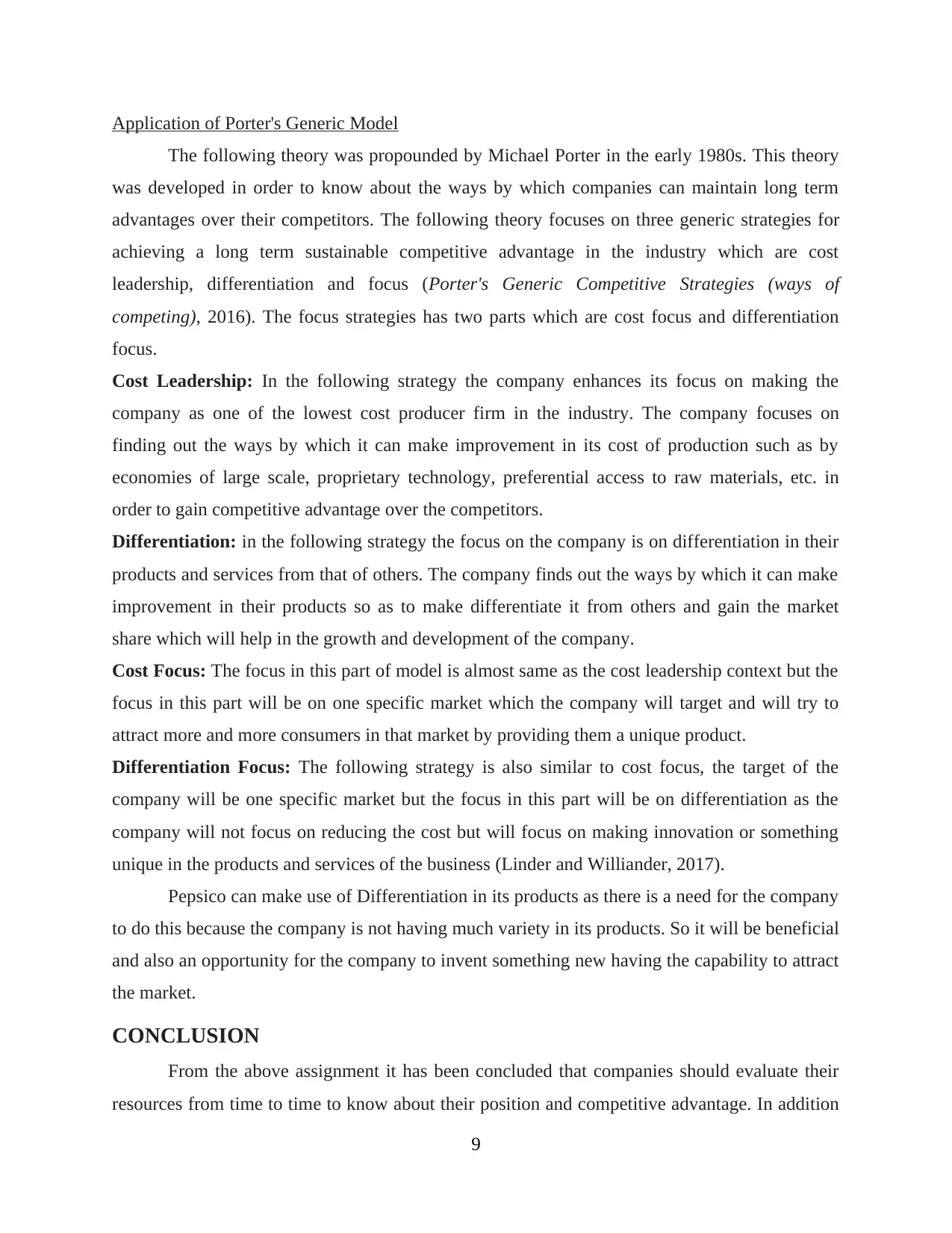
Application of Porter's Generic Model
The following theory was propounded by Michael Porter in the early 1980s. This theory
was developed in order to know about the ways by which companies can maintain long term
advantages over their competitors. The following theory focuses on three generic strategies for
achieving a long term sustainable competitive advantage in the industry which are cost
leadership, differentiation and focus (Porter's Generic Competitive Strategies (ways of
competing), 2016). The focus strategies has two parts which are cost focus and differentiation
focus.
Cost Leadership: In the following strategy the company enhances its focus on making the
company as one of the lowest cost producer firm in the industry. The company focuses on
finding out the ways by which it can make improvement in its cost of production such as by
economies of large scale, proprietary technology, preferential access to raw materials, etc. in
order to gain competitive advantage over the competitors.
Differentiation: in the following strategy the focus on the company is on differentiation in their
products and services from that of others. The company finds out the ways by which it can make
improvement in their products so as to make differentiate it from others and gain the market
share which will help in the growth and development of the company.
Cost Focus: The focus in this part of model is almost same as the cost leadership context but the
focus in this part will be on one specific market which the company will target and will try to
attract more and more consumers in that market by providing them a unique product.
Differentiation Focus: The following strategy is also similar to cost focus, the target of the
company will be one specific market but the focus in this part will be on differentiation as the
company will not focus on reducing the cost but will focus on making innovation or something
unique in the products and services of the business (Linder and Williander, 2017).
Pepsico can make use of Differentiation in its products as there is a need for the company
to do this because the company is not having much variety in its products. So it will be beneficial
and also an opportunity for the company to invent something new having the capability to attract
the market.
CONCLUSION
From the above assignment it has been concluded that companies should evaluate their
resources from time to time to know about their position and competitive advantage. In addition
9
The following theory was propounded by Michael Porter in the early 1980s. This theory
was developed in order to know about the ways by which companies can maintain long term
advantages over their competitors. The following theory focuses on three generic strategies for
achieving a long term sustainable competitive advantage in the industry which are cost
leadership, differentiation and focus (Porter's Generic Competitive Strategies (ways of
competing), 2016). The focus strategies has two parts which are cost focus and differentiation
focus.
Cost Leadership: In the following strategy the company enhances its focus on making the
company as one of the lowest cost producer firm in the industry. The company focuses on
finding out the ways by which it can make improvement in its cost of production such as by
economies of large scale, proprietary technology, preferential access to raw materials, etc. in
order to gain competitive advantage over the competitors.
Differentiation: in the following strategy the focus on the company is on differentiation in their
products and services from that of others. The company finds out the ways by which it can make
improvement in their products so as to make differentiate it from others and gain the market
share which will help in the growth and development of the company.
Cost Focus: The focus in this part of model is almost same as the cost leadership context but the
focus in this part will be on one specific market which the company will target and will try to
attract more and more consumers in that market by providing them a unique product.
Differentiation Focus: The following strategy is also similar to cost focus, the target of the
company will be one specific market but the focus in this part will be on differentiation as the
company will not focus on reducing the cost but will focus on making innovation or something
unique in the products and services of the business (Linder and Williander, 2017).
Pepsico can make use of Differentiation in its products as there is a need for the company
to do this because the company is not having much variety in its products. So it will be beneficial
and also an opportunity for the company to invent something new having the capability to attract
the market.
CONCLUSION
From the above assignment it has been concluded that companies should evaluate their
resources from time to time to know about their position and competitive advantage. In addition
9

to this, it is also concluded that companies must take into consideration the relation in between
the company and their stakeholder so as to keep them happy. Further the company should also
understand the importance of organisation's culture as it impacts upon the growth and
sustainability of an organisation.
10
the company and their stakeholder so as to keep them happy. Further the company should also
understand the importance of organisation's culture as it impacts upon the growth and
sustainability of an organisation.
10
⊘ This is a preview!⊘
Do you want full access?
Subscribe today to unlock all pages.

Trusted by 1+ million students worldwide
1 out of 13
Related Documents
Your All-in-One AI-Powered Toolkit for Academic Success.
+13062052269
info@desklib.com
Available 24*7 on WhatsApp / Email
![[object Object]](/_next/static/media/star-bottom.7253800d.svg)
Unlock your academic potential
Copyright © 2020–2025 A2Z Services. All Rights Reserved. Developed and managed by ZUCOL.





